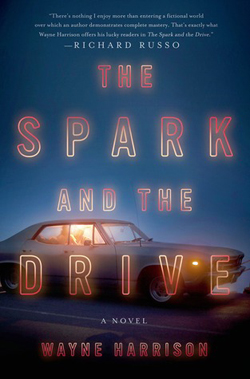The Spark and the Drive
by Wayne Harrison
reviewed by Henry Hughes
There are plenty of movies featuring cars, miles of pop- and hip-hop-hailing coupes and low riders, and yet the literary lot seems pretty empty. Evelyn Waugh writes a terrifying chase, John Updike’s characters meditate behind the wheel and run dealerships, J. G. Ballard explores freaky collision fetishes in Crash, and, of course, there are the epic road trips of Jack Kerouac and Hunter Thompson. But few writers have ever gotten in the garage and under the hood as Wayne Harrison does in this excellent novel.
It’s the mid-1980s in rusty, rundown Waterbury, Connecticut, where our narrator, Justin, a vocational high school student, lands an internship at Out of the Hole, an auto repair shop renowned for its work on American muscle cars. The book opens with Justin staying late to help the owners, master mechanic Nick and his beautiful wife, Mary Ann. Nick is wise and strong, a loving husband and father, a fair boss, and an amazing driver—just the kind of mentor Justin longs for. Mary Ann is fit, tender, a good businesswoman and fond of cars. When it gets too hot they all decide to take a wild ride in a customer’s ’67 Rally Sport Camaro. The other shops in town turned down the collector’s temperamental convertible—“Most mechanics come to accept that some cars just aren’t fixable”—but Nick “has yet to open the hood on an unfixable car.” What follows is a relationship running too rich on lust and envy that tests the limits of machines and people—as well as the notion that all engines are fixable.
Wayne Harrison spent several years working as an automotive mechanic and his language rings true of the well-lubed vernacular transitioning reluctantly toward technical diagnostics. Just as you don’t need to be a gear head to enjoy NPR’s Car Talk, readers who’ve never changed their own oil or drag-raced will still feel the force of this great story accented with “chirping tires,” the “vinegary haze of drying rubber,” and “feathering the brakes.” Working hard to fix a stalling Formula, an exhausted Justin finally tells us he “couldn’t see the whirling slot mark on the harmonic balancer” and nearly gives up until Nick taps the EGR valve and gets the engine idling. There are beautiful, clear descriptions of combustion engines that emerge unselfconsciously as metaphors for a dizzying complexity that is also a kind of calming order. Engine work provides the reliability that Justin admits “was lacking from my everyday life.” People, he will soon learn, are not so predictable.
When Justin visits Nick and Mary Ann over Christmas break, he learns that they have lost their baby to SIDS. The trauma has badly shaken the couple, and when Justin returns to work the following June he discovers that Nick’s repairs are coming back with what appear to be errors—a loose oil plug or fuel clamp, a misplaced screwdriver. The troubled Nick reaches out to Justin as a friend, and a lonely and ignored Mary Ann takes Justin as her lover. The teenager is thrilled by these intense adult relationships, but their increasing RPMs nearly destroy his life and those around him.
We often associate muscle cars—Corvettes, Firebirds, Chargers, Chevells, and Justin’s own Plymouth Hemi ’Cuda—with overwrought machismo, but the novel does not apologize for this kind of masculinity. Justin identifies not with fuel-efficient environmentalism but with power and speed, not with college life but with hands-on problem solving. He sees the mechanic as “the perfect masculine blend of strength and intelligence”; more importantly, he tells us, “I had no father—not one I admitted to having.” His father, a literary agent whom Justin always refers to as “Don,” has come out as gay and started a new life away from Justin’s mother and four-year-old sister. There are no stereotyped bashings here, however, and father and son begin to bridge some differences. But Justin likes hot girls and fast cars, insisting that he needs this “unapologetic mechanic life to transform me into the man I wanted to be.” Predictably, this teenage boy cannot always handle big emotional surges, though in this he is not alone: theft and sabotage burn through the best people when they’re desperate.
There are a few extraordinary coincidences in the novel which fuel the plot but also remind us a bit too much of the driver, and some minor implausibilities like a struggling-to-make-ends-meet mother who drinks Tanqueray gin (when Gordon’s is half the price). But I’d ride with this clear-headed driver any time. In a spare 275 pages, Harrison gives us the grimy inside life of the mechanic’s trade and the discipline’s transcendent possibilities—the blistering blast of a punctured radiator and the steamiest front-seat sex, grand theft auto, and small-town drag-racing with a rare Corvette ZL-1. This is a powerful story of cars, friendship, romance, tragedy, and the human necessity to keep driving. A great American car novel just pulled up.
Published on October 9, 2014

